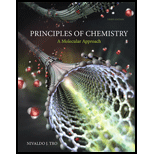
Concept explainers
Consider the reaction.
A reaction mixture initially contains 5 moles of NO and 10 moles of
a. 1 mol NO, 0 mol
b. 0 mol NO, 1 mol
c. 3 mol NO, 5 mol
d. 0 mol NO, 0 mol
Want to see the full answer?
Check out a sample textbook solution
Chapter 4 Solutions
Principles of Chemistry: A Molecular Approach Plus Mastering Chemistry with eText -- Access Card Package (3rd Edition) (New Chemistry Titles from Niva Tro)
- list at least three quantities that must be conserved in chemical reactions.arrow_forwardCarbon dioxide from the atmosphere weathers, or dissolves, limestone (CaCO3) by the reaction CaCO3(s)+CO2(g)+H2O(l)Ca2(aq)+2HCO3(aq) Obtain H for this reaction. See Table 6.2 for the data.arrow_forwardThe carbon dioxide exhaled in the breath of astronauts is often removed from the spacecraft by reaction with lithium hydroxide 2LiOH(s)+CO2(g)Li2CO3(s)+H2O(l) Estimate the grams of lithium hydroxide required per astronaut per day. Assume that each astronaut requires 2.50 103 kcal of energy per day. Further assume that this energy can be equated to the heat of combustion of a quantity of glucose, C6H12O6, to CO2(g) and H2O(l). From the amount of glucose required to give 2.50 103 kcal of heat, calculate the amount of CO2 produced and hence the amount of LiOH required. The H for glucose(s) is 1273 kJ/mol.arrow_forward
- Ethanol, C2H5OH, is a gasoline additive that can be produced by fermentation of glucose. C6H12O62C2H5OH+2CO2 (a) Calculate the mass (g) of ethanol produced by the fermentation of 1.000 lb glucose. (b) Gasohol is a mixture of 10.00 mL ethanol per 90.00 mL gasoline. Calculate the mass (in g) of glucose required to produce the ethanol in 1.00 gal gasohol. Density of ethanol = 0.785 g/mL. (c) By 2022, the U. S. Energy Independence and Security Act calls for annual production of 3.6 1010 gal of ethanol, no more than 40% of it produced by fermentation of corn. Fermentation of 1 ton (2.2 103 lb) of corn yields approximately 106 gal of ethanol. The average corn yield in the United States is about 2.1 105 lb per 1.0 105 m2. Calculate the acreage (in m2) required to raise corn solely for ethanol production in 2022 in the United States.arrow_forwardA common demonstration in chemistry courses involves adding a tiny speck of manganese(IV) oxide to a concentrated hydrogen peroxide (H2O2) solution. Hydrogen peroxide decomposes quite spectacularly under these conditions to produce oxygen gas and steam (water vapor). Manganese(IV) oxide is a catalyst for the decomposition of hydrogen peroxide and is not consumed in the reaction. Write the balanced equation for the decomposition reaction of hydrogen peroxide.arrow_forwardExplain how an equation can be balanced even if the number of reactant particles differs from the number of product particles.arrow_forward
- 4.8 In an experiment carried out at very low pressure, 13x1015 molecules of H2 are reacted with acetylene, C2H2, to form ethane, C2H6, on the surface of a catalyst. Write a balanced chemical equation for this reaction. How many molecules of acetylene are consumed?arrow_forwardTable 6.1 lists some clues that a chemical reaction has occurred. However, these events do not necessarily prove the existence of a chemical change. Give an example for each of the clues that is not a chemical reaction but a physical change.arrow_forwardThe final step in the manufacture of platinum metal (for use in automotive catalytic converters and other products) is the reaction 3 (NH4)2PtCl6(s) 3 Pt(s) + 2 NH4Cl(s) + 2 N2(g) + 16 HCl(g) Complete this table of reaction quantities for the reaction of 12.35 g (NH4)2PtCl6.arrow_forward
- Ammonia can be formed by a direct reaction of nitrogen and hydrogen. N2(g) + 3 H2(g) 2 NH3(g) A tiny portion of the starting mixture is represented by the diagram, where the blue circles represent N and the white circles represent H. Which of these represents the product mixture? For the reaction of the given sample, which of these statements is true? (a) N2 is the limiting reactant. (b) H2 is the limiting reactant. (c) NH, is the limiting reactant. (d) No reactant is limiting: they are present in the correct stoichiometric ratio.arrow_forward4.68 The pictures below show a molecular-scale view of a chemical reaction between the compounds AB2 and B2. (Green balls represent B atoms and orange balls are A atoms). The box on the left represents the reactants at the instant of mixing, and the box on the right shows what is left once the reaction has gone to completion. Was there a limiting reactant in this reaction? If so, what was it? Write a balanced chemical equation for this reaction. As usual, your equation should use the smallest possible whole number coefficients for all substances.arrow_forwardPolychlorinated biphenyls (PCBs) have been used extensively as dielectric materials in electrical transformers. Because PCBs have been shown to be potentially harmful, analysis for their presence in the environment has become very important. PCBs are manufactured according to the following generic reaction: C12H10+nCl2C12H10nCln.+nHCl This reaction results in a mixture of PCB products. The mixture is analyzed by decomposing the PCBs and then precipitating the resulting Cl asAgCl. a. Develop a general equation that relates the average value of n to the mass of a given mixture of PCBs and the mass of AgCl produced. b. A 0.1947-g sample of a commercial PCB yielded 0.4791 g of AgCl. What is the average value of n for this sample?arrow_forward
 Chemistry: The Molecular ScienceChemistryISBN:9781285199047Author:John W. Moore, Conrad L. StanitskiPublisher:Cengage Learning
Chemistry: The Molecular ScienceChemistryISBN:9781285199047Author:John W. Moore, Conrad L. StanitskiPublisher:Cengage Learning ChemistryChemistryISBN:9781305957404Author:Steven S. Zumdahl, Susan A. Zumdahl, Donald J. DeCostePublisher:Cengage Learning
ChemistryChemistryISBN:9781305957404Author:Steven S. Zumdahl, Susan A. Zumdahl, Donald J. DeCostePublisher:Cengage Learning Chemistry: An Atoms First ApproachChemistryISBN:9781305079243Author:Steven S. Zumdahl, Susan A. ZumdahlPublisher:Cengage Learning
Chemistry: An Atoms First ApproachChemistryISBN:9781305079243Author:Steven S. Zumdahl, Susan A. ZumdahlPublisher:Cengage Learning
 Chemistry for Engineering StudentsChemistryISBN:9781285199023Author:Lawrence S. Brown, Tom HolmePublisher:Cengage Learning
Chemistry for Engineering StudentsChemistryISBN:9781285199023Author:Lawrence S. Brown, Tom HolmePublisher:Cengage Learning Chemistry for Engineering StudentsChemistryISBN:9781337398909Author:Lawrence S. Brown, Tom HolmePublisher:Cengage Learning
Chemistry for Engineering StudentsChemistryISBN:9781337398909Author:Lawrence S. Brown, Tom HolmePublisher:Cengage Learning





